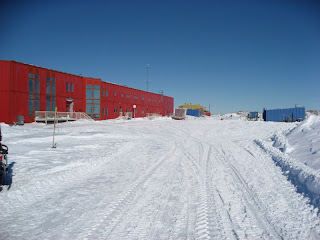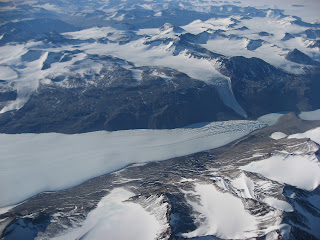Recently I was asked to provide pictures of wildlife, icebergs, station life or all things frozen - so I politely provided him with the following photo ...
| 'All Things Frozen' |
Anyhow back to the story -
On arrival at any of the Australian continental Antarctic Stations (Casey, Davis and Mawson) all expeditioners are required to undertake a station induction and a series of survival and field training days which consist of (re) learning the required skills to travel 'safely' within specific areas of the continental stations for work or recreational purposes.
The station induction is in the form of a walk around the station highlighting the various buildings and their purpose to new and returning expeditioners. All Australian continental station buildings are brightly coloured, affectionately termed as ‘Lego Land’. The walk incorporates buildings such at the Red Shed (living area), EVS (Emergency Vehicle Station), Green Store (warehouse), mechanical workshop, science building, tank house and other buildings of significance.
 |
| Red Shed (and main street) |
 |
| Workshop to the left & Field Store on the right |
 |
| EVS on the left & Green Store on the right |
Before heading off station limits and into the field, first the Antarctic clothing is explained to us. There is kit and equipment which are required to be worn and to be carried in our backpacks.
Necessary items to wear are goggles and gloves, woollen thermal underwear (close to the body), insulated layer of fleece clothing (middle layer of clothing) and finally the windproof outer clothing.
 |
| Me wearing the windproof outer clothing (Carhartts) |
Cotton clothing is a very poor idea to wear because as we sweat during exertion, the cotton will retain the moisture and you will soon become cold. Such things as windproof jacket and over-pants, windproof mitts or gloves (and spares), balaclava, goggles, sleeping bag and mat, whistle and signal mirror, compass and map, high energy food, thermos or water bottle, throw bag and finally spikes which fit over the boot.
Besides those necessary items there are spare clothes to pack, food, water, VHF radio, pee bottle and any other personal items (toothbrush).
Once this had been explained then certain procedures are to be followed before we can leave. This includes ‘turning your fire tag’ so in case of a fire, you can be accounted for as being off station. By placing your name tag and those tags of the people accompanying you, writing up where you are going, when you will return and on what VHF channel you will monitor while away would conclude the outcome of this task.
 |
| Fire Tag Board (radio console in front) |
Then it is up to the radio room, and once again, filling out similar details on the board there informing the on watch communications operator of the callsign you will be using and the nightly sked time.
Then, finally, we move off station limits and into the recreational area.
First lesson – cutting steps into ice cliffs allowing foot holds to allow walking up or down reasonably steep ice mounds. This requires the use of an ice axe using the adze to cut the ice in a way that allows a foot to sit comfortably while cutting another foot hold and so forth until you have reached the summit or the ground.
Next lesson was crossing the sea ice to Shirley Island. On the island are numerous Adelie penguin colonies. However there is usually a channel of water between the station and Shirley Island. This area will remain frozen for a period of time until it warms up enough to decay and eventually be blown out to sea.
 |
| Sea ice channel between Shirley Island and mainland (picture taken from Shirley Island) |
Before proceeding onto the sea ice and crossing it to Shirley Island, radio room is to be informed that the party is about to cross. Then the ice is to be drilled to check the thickness to ensure it is 40cm or thicker which is the minimum safe thickness to cross by foot.
 |
| Sea ice drilling |
Once the required thickness had been determined, we then crossed and located an Adelie penguin colony and watched the antics they put on show. Presently they are returning to the island, building their nests and finally mating. It is funny to watch them build their nests as the nests are created from small pebbles which they steal from one another’s nests which does cause resentment and the odd biff.
 |
| Adelie Colony |
 |
| Adelie's nesting on small pebbles |
 |
| Adelie Penguin |
We then returned across the channel and commenced an hour or two of navigating with compass and map. Though we carry GPS units with us, it is a requirement to understand the features of a map and correctly use a compass to determine the route required to reach a certain point or destination.
Finally we set up camp for the evening. First we shared a few dry biscuits, with cheese and nibbles. Then our evening meal consisted of dehydrated food, adding hot water to ensure it was easy to consume. There were Army ration packs available which had interesting use by dates, but nevertheless tasted okay. And that was the evening cuisine.
 |
| Camp kitchen and dining area |
 |
| Camp |
 |
| Preparing the meal |
As this was ‘survival training’ we were all required to ‘bivvy’ outside in the open. Various shelters created from ice were undertaken to ensure if the wind increased during the night that we were adequately covered and protected from the associated ‘chill factor’. Ice brick walls, igloos, and other various ‘abodes’ were invented.
 |
| Looks comfortable right ?? Right!!! |
 |
| The 'igloo' as such |
 |
| Seamus putting on sunscreen before retiring |
My bed for the night consisted of me digging out a rectangular hole in the ice, ensuring it was as even as possible and no rock. I then placed two back packs at one end of the hole and then proceed to pack the ice I had just dug out over the two packs.
 |
| My bed before burying the backpacks |
 |
| My bed with backpacks buried - I dug them out after 2 hours and it formed an enclosure for me |
I let the ice form for a few hours and then I dug the two packs out from inside the hole. Once this was successfully completed I then had a cover over one end of the hole which protected me from the sun (we have 24 hour daylight now) and any wind which may come up during the night.
It is an effort putting oneself to bed when bivvying out. First of all you have to place a thin mat inside the bivvy bag, then also place the sleeping bag inside. Then you select what clothes you are going to sleep in and climb in. Sound simple?? Nah, trust me. First you have to pee into the bottle as you really do not want to get out of the sleeping bag during the night.
Apart from the pee bottle, there is a flour drum with a plastic bag in it to use if that requirement was needed. The rule is that whoever uses the drum first has to take the contents (in the bag of course) back to station for burning. No human waste or other grey water (washing up water for example) is allowed to remain behind.
 |
| Grey water container - the 'other' container is in the tent |
Anyhow, once I have climbed into the sleeping bag liner, then into the sleeping bag and then into the bivvy bag, I drag my back pack in with me, my boots, and anything else which may freeze during the night or get blown away. It is a useful trick to place socks, underwear, and other clothes in the sleeping bag with you, so that they are warm and unfrozen in the morning.
The night (ha) is not comfortable, but survivable if this need ever arose. I woke many times, mainly when rolling over and looking for a comfortable position to lie in, or pushing away my back pack and boots or feeling thin ice falling onto my face from frozen condensation. And I needed to pee. Positioning one self (carefully) while in the sleeping bag it is amazing what can be achieved!!
In the morning the wind had come up and attempting to dress correctly (I slept in my thermal underwear, the fleece layer of clothing and beanie) was difficult and very cold. But the quicker you dress and then throw ice onto your bivvy bag to weigh it down so it won’t blow away, allows me to walk around and warm up. Once I have warmed up I returned to my bivvy bag and carefully packed everything up into my back pack. I was unable to take a drink of water as the bottle had froze during the night – lesson learned – place it in the bivvy bag with you when preparing for sleep.
Next blog will be the ‘field training’ where we use the quad bike and travel out further and visit two field huts.
Here is a taste of some of the pictures to expect …..
 |
| Adelie Penguin |














